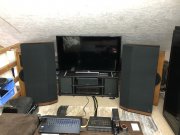I've been amassing a bunch of speakers over the past several years, Ortofon 445, 335, ADS L990, L9e, L620, and now L1230. Yes, I have a problem, but I have come to appreciate how the WOPL 400-II sounds SO DAMN GOOD, no matter what I throw at it. Pretty much all speakers have needed some kind of hand-tending when I took ownership; re-foaming the cones of nearly all woofers and sourcing drivers, or sending the ADS parts to the amazing Richard So.
I need to thank @J!m for bringing forward a CL ad for the L1230s recently. These are in remarkable condition, but some elements will need some freshening by "Dr. So".
These speakers have connections for standard/full range connections as well as the (switched) option to run in bi-amped configuration where the two woofers are driven separately from the midrange/tweeter pair. According to the instructions ADS had a crossover system, C2000, for the Lxx30 series...and naturally it is nearly impossible to find. I am thinking to try a MiniDSP as an active crossover, but curious about amplifier selection to drive the high and low sections. I have the WOPL 400-II, as well as a Carver MXR130 and a MXR150 that were put into storage by the WOPL 400-II.
At this point I am more curious about bi-amplification, because the binding posts on the back of the L1230s have piqued my interest. Thoughts and reflections from anybody who has gone down this path ... worthwhile or too much of a hassle for what is gained from bi-amping? Are either of those Carver amps even worth considering or just leave them collecting dust? Setting up the MiniDSP would likely be a challenge onto itself, as I have no experience with figuring out the crossover sweet-spots. According to Richard, the L1230 crossover point is 655Hz with the C2000, but I don't know what the slope rate is and type of crossover (Linkwitz/Riley, or other etc).
Any insight would be appreciated
Thanks!
I need to thank @J!m for bringing forward a CL ad for the L1230s recently. These are in remarkable condition, but some elements will need some freshening by "Dr. So".
These speakers have connections for standard/full range connections as well as the (switched) option to run in bi-amped configuration where the two woofers are driven separately from the midrange/tweeter pair. According to the instructions ADS had a crossover system, C2000, for the Lxx30 series...and naturally it is nearly impossible to find. I am thinking to try a MiniDSP as an active crossover, but curious about amplifier selection to drive the high and low sections. I have the WOPL 400-II, as well as a Carver MXR130 and a MXR150 that were put into storage by the WOPL 400-II.
At this point I am more curious about bi-amplification, because the binding posts on the back of the L1230s have piqued my interest. Thoughts and reflections from anybody who has gone down this path ... worthwhile or too much of a hassle for what is gained from bi-amping? Are either of those Carver amps even worth considering or just leave them collecting dust? Setting up the MiniDSP would likely be a challenge onto itself, as I have no experience with figuring out the crossover sweet-spots. According to Richard, the L1230 crossover point is 655Hz with the C2000, but I don't know what the slope rate is and type of crossover (Linkwitz/Riley, or other etc).
Any insight would be appreciated
Thanks!
Attachments
-
291.5 KB Views: 10

